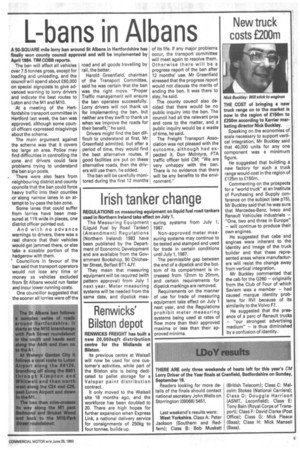Lbans in Albans
Page 7

If you've noticed an error in this article please click here to report it so we can fix it.
A 50-SQUARE mile lorry ban around St Albans in Hertfordshire has finally won county council approval and will be implemented by April 1984. TIM COBB reports.
The ban will affect all vehicles over 7.5 tonnes gross, except for loading and unloading, and the council will spend about £60,000 on special signposts to give advanced warning to lorry drivers and indicate the best routes to Luton and the M1 and M10.
At a meeting of the Hertfordshire transport committee in Hertford last week, the ban was approved, although some council officers expressed misgivings about the scheme.
The main argument against the scheme was that it covers too large an area. Police may find difficulties in controlling the zone and drivers could face problems trying to understand the ban sign posts.
There were also fears from neighbouring district and county councils that the ban could force heavy traffic into their counties or along narrow lanes in an attempt to by-pass the ban zone.
Some lanes that could suffer from lorries have been measured at lift wide in places, one district officer pointed out.
And with no advance warnings to drivers, there was a real chance that their vehicles would get jammed there, or else take a sizeable portion of the hedgerow with them.
Councillors in favour of the ban said that transport operators would not lose any time or money as vehicles excluded from St Albans would run faster and incur lower running costs.
One councillor suggested that the sooner all lorries were off the road and all goods travelling by rail, the better.
Harold Greenfield, chairman of the Transport Committee, said he was certain that the ban was the right move. "Proper Traffic management will ensure the ban operates successfully. Lorry drivers will not thank us for implementing the ban, but neither are they swift to thank us when we improve the roads for their benefit," he said.
Drivers might find the ban difficult to understand at first, Mr Greenfield admitted, but after a period of time, they would find the best alternative routes. If good facilities are put on these alternative roads, then the drivers will use them, he added.
The ban will be carefully monitored during the first 12 months of its life. If any major problems occur, the transport committee will meet again to resolve them. Otherwise there will be a progress report of the ban after 12 months' use. Mr Greenfield stressed that the progress report would not discuss the merits of ending the ban. It was there to stay, he said.
The county council also decided that there would be no public inquiry into the ban. The council had all the relevant pros and cons to the matter, and a public inquiry would be a waste of time, he said.
The Freight Transport Association was not pleased with the outcome, although had expected it. Don McIntyre, FTA traffic officer told CM; "We are very unhappy with the ban. There is no evidence that there will be any benefits to the environment."








































































































